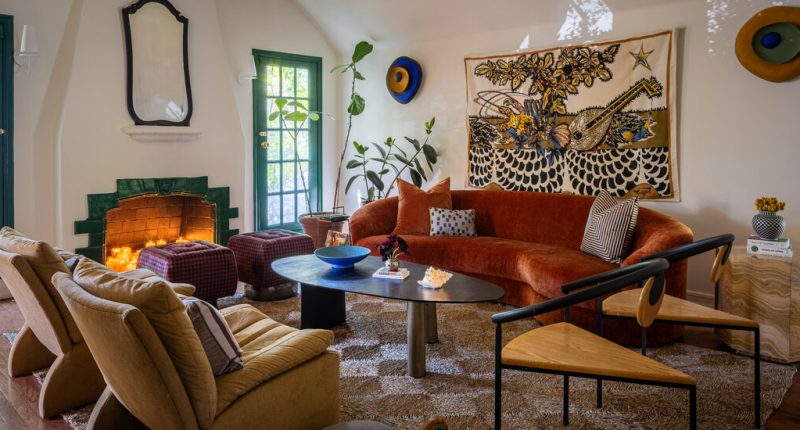
The City of Angels remains a city of teardowns. Despite ordinances to preserve Los Angeles’s classic little bungalows, those charming dollops from the early 20th century that have helped define the city’s architectural character continue to be replaced by McMansions and apartment blocks.
One house that slipped through the cracks is a 1927 Spanish Colonial-slash-Craftsman in the Fairfax neighborhood, just south of West Hollywood. In the fall of 2020, Siena Deck, currently a production assistant at HBO, won an eight-way bidding war to claim the heartbreaker, paying $1.29 million.
The 1,228-square-foot house, with two bedrooms and two bathrooms, is tucked into a lush pocket two blocks from Melrose Avenue, in an area known for its large Orthodox Jewish community. The interior is all arches and curves. Outside, jacaranda trees turn the grounds purple in spring. But what really impressed Ms. Deck, 25, were the decorative and frequently imperfect marks left by the former occupants, who lived there for 17 years.
As Ms. Deck later discovered, the bungalow and its previous owners, Stella Alberti, a wedding dress designer, and her husband, Pedro Alberti, an artist, were featured in a popular home décor book from 2015 called “The New Bohemians.” The author, Justina Blakeney, pegged the couple as “folksy bohemians,” who packed their little house with “tales of adventure, treasure hunting and hand-me-downs.”
The Albertis, who were from Argentina, were clever and thrifty. When they broke a dish, Mr. Alberti applied the fragments to one of his outdoor mosaics on the property; pieces with mug handles were stuck onto a side-yard pizza oven for hanging utensils and rags. In the main bathroom, they created an island of patterned floor tiles under a slipper tub, surrounded by a sea of less expensive, plain tiles. They chose not to install window treatments, letting the sunlight filter into the living room through the dense surrounding foliage.
Ms. Deck said that the Albertis put the house on the market reluctantly, because of health reasons, and her clear appreciation for its embedded soul won them over. When she sought help in remodeling it a year later, she was determined to preserve its ready-made charm.
“Layer me into this,” she told Kristina Khersonsky, the principal of Studio Keeta, a three-year-old interior design firm in Los Angeles.
Dutifully, Ms. Khersonsky kept the Albertis’ cobalt blue kitchen tiles, which she described as “cute, quirky and wonky.” She matched them to a new, farmhouse-style apron sink and echoed the same blue color in custom papier-mâché wall sconces that are visible in the open-plan living room.
The tiles also informed the designer’s choice of pale avocado kitchen cabinets to replace the existing wood-finished ones. With their handmade look, the cabinets “could be a D.I.Y. weekend project,” she said, and this was a good thing — she didn’t want them to appear too sleek in their rustic setting.
“Layering in” Ms. Deck meant incorporating her love of color. Ms. Khersonsky retained the off-white living room wall color but specified an intense dark green for the molding of the tall, mullioned windows and geometric, brick fireplace surround. The hue harmonizes with the outdoor foliage that, seen through the windows, continues to be a dominant interior element. (Even before Ms. Deck learned of the previous owners’ aversion to blinds, she asked to leave the living room windows bare.)
The living room furnishings include a 1980s sofa recovered in orange velvet, a 1950s Jean Lurcat tapestry in shades of cobalt and gold and a pair of red, diamond-patterned poufs. In the main bathroom, the original tiles are complemented by Ms. Deck’s choice of pink-orange wall paint. The dining room, which sits between the kitchen and living room, is coated in a rich maroon semigloss (Preference Red by Farrow & Ball). Sea-foam green schoolhouse chairs surround a Spanish-inspired mahogany trestle dining table, and a wavy rail Ms. Deck found on Etsy demarcates the raised space (and prevents visitors from falling off the edge and into the tiled entryway).
Two rooms were left pure white for visual relief: a little glassed-in dining nook off the kitchen and Ms. Deck’s bedroom, with its splashes of green textiles.
“I don’t even have a headboard,” she said of her unfussy bed. (The second bedroom, which has not been updated, is rented to a friend who comes and goes.) The renovation cost less than $40,000, including the kitchen remodel.
Ms. Khersonsky also incorporated Ms. Deck’s artistic identity. On the dining room wall hangs a maroon-accented painting the homeowner did of two figures leaning into an embrace.
“The man is kind of lying on top of the woman, so she is in the power position, comforting him,” Ms. Deck said. “This is a woman’s house. If I’m going to create a piece of art that’s in a focal point of the house, I want to be sure it has a woman and she’s uplifting.”
Living Small is a biweekly column exploring what it takes to lead a simpler, more sustainable or more compact life.
For weekly email updates on residential real estate news, sign up here.
Source: | This article originally belongs to Nytimes.com








